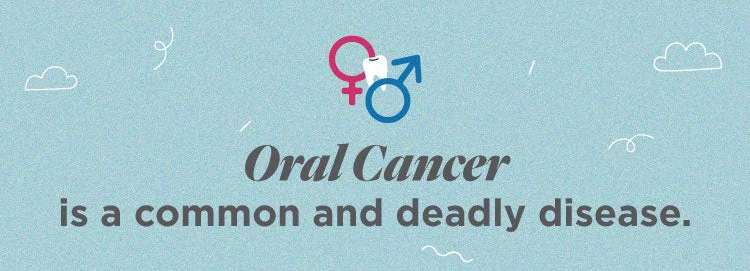Physical Differences Between Men's and Women's Oral Health
Hormones' Impact on Men's and Women's Oral Health
How Do Hormones Impact Your Oral Health?

Men's Oral Health vs. Women's Oral Health
Potential Risk for Men Vs. Women from Sex Hormones
Women, who experience hormonal changes regularly throughout their life stages, have more acute reactions to hormone changes. For example, the estrogen receptors in women's oral cavity react to changes with estrogen, leading to oral health problems such as bleeding or sensitive gums, development of early-stage gum disease (called gingivitis) with increases in estrogen, and dry mouth, among other symptoms, with decreases in estrogen. [ii]
Risk Factors for Men's Oral Health

Men are Less Likely to Visit the Dentist
Men's Risks
Risk Factors for Women's Oral Health
Women's Risks

Oral Cancer Impact of the Sexes
Men and Women and Oral Cancer
Positive and Negative Habits Impact on Oral Health
Find a Dentist Near You
Do you want to know more about the differences in the sexes regarding oral health, oral cancer risks, or how your hormones could affect oral health? Our Smile Generation team can help with answers and provide care and advice on what you need for optimal oral healthcare. For more information or to find a Smile Generation®- trusted dentist near you, use our Find a Dentist Tool.
Find your trusted, local dentist today!
Sources
[i] Nascimento WV, Cassiani RA, Dantas RO. Gender effect on oral volume capacity. Dysphagia. 2012;27(3):384-389. doi:10.1007/s00455-011-9379-4
[ii] myclevelandclinic.org. n.d. Hormones: What They Are, Function & Types. [online] Available at: <https://my.clevelandclinic.org/health/articles/22464-hormones> [Accessed 9 August 2022].
[iii] Grover CM, More VP, Singh N, Grover S. Crosstalk between hormones and oral health in the mid-life of women: A comprehensive review. J Int Soc Prev Community Dent. 2014;4(Suppl 1):S5-S10. doi:10.4103/2231-0762.144559
[i] Benscosme, RDH, MA, CHES, J., 2016. Sex-Based Differences in Oral Health - Dimensions of Dental Hygiene | Magazine. [online] dimensionsofdentalhygiene.com. Available at: <https://dimensionsofdentalhygiene.com/article/sex-based-differences-in-oral-health/> [Accessed 9 August 2022].
[ii] perio.org. n.d. Gum Disease and Women - American Academy of Periodontology. [online] Available at: <https://www.perio.org/for-patients/gum-disease-information/gum-disease-and-women/> [Accessed 10 Aug 2022].
[iii] Men's vs. women's oral health. Grin.deltadentalins.com. https://grin.deltadentalins.com/archive/2018/fall/men-vs-women-oral-health/. Published 2018. Accessed August 10, 2022.
[iv] Benscosme, RDH, MA, CHES, J., 2016. Sex-Based Differences in Oral Health - Dimensions of Dental Hygiene | Magazine. [online] dimensionsofdentalhygiene.com. Available at: <https://dimensionsofdentalhygiene.com/article/sex-based-differences-in-oral-health/> [Accessed 9 August 2022].
[v] Lipsky MS, Su S, Crespo CJ, Hung M. Men and Oral Health: A Review of Sex and Gender Differences. Am J Men's Health. 2021;15(3):15579883211016361. doi:10.1177/15579883211016361
[vi] Lipsky MS, Su S, Crespo CJ, Hung M. Men and Oral Health: A Review of Sex and Gender Differences. Am J Men's Health. 2021;15(3):15579883211016361. doi:10.1177/15579883211016361
[vii] Lipsky MS, Su S, Crespo CJ, Hung M. Men and Oral Health: A Review of Sex and Gender Differences. Am J Men's Health. 2021;15(3):15579883211016361. doi:10.1177/15579883211016361
[viii] Lipsky MS, Su S, Crespo CJ, Hung M. Men and Oral Health: A Review of Sex and Gender Differences. Am J Men's Health. 2021;15(3):15579883211016361. doi:10.1177/15579883211016361
[ix] Singh BP, Makker A, Tripathi A, Singh MM, Gupta V. Association of testosterone and bone mineral density with tooth loss in men with chronic periodontitis. J Oral Sci. 2011;53(3):333-339. doi:10.2334/josnusd.53.333
[x] Kellesarian SV, Malmstrom H, Abduljabbar T, et al. "Low Testosterone Levels in Body Fluids Are Associated With Chronic Periodontitis". Am J Men's Health. 2017;11(2):443-453. doi:10.1177/1557988316667692
[xi] Lipsky MS, Su S, Crespo CJ, Hung M. Men and Oral Health: A Review of Sex and Gender Differences. Am J Men's Health. 2021 May-Jun;15(3):15579883211016361. DOI: 10.1177/15579883211016361. PMID: 33993787; PMCID: PMC8127762.
[xii] Benscosme, RDH, MA, CHES, J., 2016. Sex-Based Differences in Oral Health - Dimensions of Dental Hygiene | Magazine. [online] dimensionsofdentalhygiene.com. Available at: <https://dimensionsofdentalhygiene.com/article/sex-based-differences-in-oral-health/> [Accessed 9 August 2022].
[xiii] my.clevelandclinic.org. 2022. Hormones and Oral Health. [online] Available at: <https://my.clevelandclinic.org/health/articles/11192-hormones-and-oral-health> [Accessed 9 August 2022].
[xiv] Benscosme, RDH, MA, CHES, J., 2016. Sex-Based Differences in Oral Health - Dimensions of Dental Hygiene | Magazine. [online] dimensionsofdentalhygiene.com. Available at: <https://dimensionsofdentalhygiene.com/article/sex-based-differences-in-oral-health/> [Accessed 9 August 2022].
[xv] my.clevelandclinic.org. 2022. Hormones and Oral Health. [online] Available at: <https://my.clevelandclinic.org/health/articles/11192-hormones-and-oral-health> [Accessed 9 August 2022].
[xvi] Frisbee, DMD, E., 2021. Women's Hormones and Oral Health. [online] WebMD.com. Available at: <https://www.webmd.com/oral-health/hormones-oral-health> [Accessed 10 August 2022].
[xvii] Lipsky MS, Su S, Crespo CJ, Hung M. Men and Oral Health: A Review of Sex and Gender Differences. Am J Men's Health. 2021;15(3):15579883211016361. doi:10.1177/15579883211016361
[i] Lipsky MS, Su S, Crespo CJ, Hung M. Men and Oral Health: A Review of Sex and Gender Differences. Am J Men's Health. 2021 May-Jun;15(3):15579883211016361. DOI: 10.1177/15579883211016361. PMID: 33993787; PMCID: PMC8127762.
[ii] Lipsky MS, Su S, Crespo CJ, Hung M. Men and Oral Health: A Review of Sex and Gender Differences. Am J Men's Health. 2021 May-Jun;15(3):15579883211016361. DOI: 10.1177/15579883211016361. PMID: 33993787; PMCID: PMC8127762.
[iii] Lipsky MS, Su S, Crespo CJ, Hung M. Men and Oral Health: A Review of Sex and Gender Differences. Am J Men's Health. 2021 May-Jun;15(3):15579883211016361. DOI: 10.1177/15579883211016361. PMID: 33993787; PMCID: PMC8127762.
Smile Generation blog articles are reviewed by a licensed dental professional before publishing. However, we present this information for educational purposes only with the intent to promote readers’ understanding of oral health and oral healthcare treatment options and technology. We do not intend for our blog content to substitute for professional dental care and clinical advice, diagnosis, or treatment planning provided by a licensed dental professional. Smile Generation always recommends seeking the advice of a dentist, physician, or other licensed healthcare professional for a dental or medical condition or treatment.








